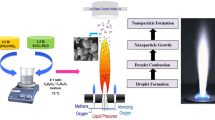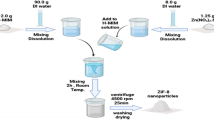Abstract
Detonation nanodiamonds (DND) represent a unique material combining the properties of a rather passive diamond core with an active carbon shell. The effect of disaggregated DND (T-DND) and detonation carbon [diamond batch mixture (T-DBM)] obtained in an explosion of tetryl (2,4,6-trinitro-N-methyl-N-nitroaniline) and preliminary deposited onto ammonium perchlorate granules in the process of its crystallization on the burning rate of a paste-like propellant is studied. T-DND is preliminary cured at 430°C for two hours. The method used in the present study is chemical deposition (forced crystallization) of ammonium perchlorate from a saturated aqueous solution also containing T-DND or T-DBM by isopropanol in the ratio of 1/2. The burning rates of compositions are determined as functions of pressure in the range up to 1200 atm. It is demonstrated that the use of detonation nanodiamonds and diamond batch mixture leads to an increase in the propellant burning rate approximately by 26 and 15%, respectively, while the temperature of combustion products decreases approximately by 240°C at 100 atm.


Similar content being viewed by others
REFERENCES
V. A. Gorbachev, E. Yu. Ubei-Volk, N. V. Shevchenko, and A. A. Golubev, “Detonation Nanodiamond as a Promising Component of Composite Propellants," Khim. Tekhnol. Neorgan. Organ. Veshchestv, Teor. Osn. 59 (8), 96–100 (2016); DOI: 10.6060/tcct.20165908.37y.
V. Gorbachev and N. Shevchenko, “Influence of Nanodiamond on Combustion of Anazite," in Collection of Abstr. of XII Int. Symp. of Explosive Production of New Materials, Cracow, May 25-30, 2014, pp. 191–192.
N. V. Shevchenko, V. A. Golubev, E. Yu. Ubei-Volk, et al., “Effect of Detonation Nanodiamonds on the Processes of Combustion of High Explosives," Konstr. Kompoz. Mater. No. 3 (135), 33–39 (2014).
A. S. Barnard and M. Sternberg, “Crystallinity and Surface Electrostatics of Diamond Nanocrystals," J. Mater. Chem. 17, 4811–4819 (2007); DOI: 10.1039/B710189A.
L.-Y. Chang, E. Ōsawa, and A. S. Barnard, “Confirmation of the Electrostatic Self-Assembly of Nanodiamonds," Nanoscale, No. 3, 958–962 (2011); DOI: 10.1039/C0NR00883D.
V. D. Blank, A. A. Golubev, V. A. Gorbachev, et al., “Microdiamonds from Detonation Synthesis," Izv. Vyssh. Uchebn. Zaved., Khim. Khim. Tekhnol. 55 (6), 37–41 (2012).
N. V. Shevchenko, V. A. Gorbachev, V. A. Choabanyan, et al., “Properties and Phase Composition of the Surface of Detonation Diamonds," Izv. Vyssh. Uchebn. Zaved., Khim. Khim. Tekhnol. 59 (8), 40–44 (2016); DOI: 10.6060/tcct.20165908.36y.
V. Yu. Dolmatov, “Ultrafine Diamonds from Detonation Synthesis: Properties and Applications," Usp. Khim. 70 (7), 687–708 (2001); DOI: 10.1070/RC2001v070n07ABEH000665.
V. Yu. Dolmatov, “Chapter 11. Synthesis and Post-Synthesis Treatment of Detonation Nanodiamond," in Ultrananocrystalline Diamond. Synthesis, Properties, and Applications, Ed. by O. A. Shenderova and D. M. Gruen (William Andrew Inc., New York, 2006), pp. 347–377; DOI: 10.1016/B978-081551524-1.50013-5.
V. Yu. Dolmatov, “Detonation Nanodiamonds: Synthesis, Structure, Properties, Applications," Usp. Khim. 76 (4), 375–397 (2007); DOI: 10.1070/ RC2007v076n04ABEH003643.
Detonation Nanodiamonds. Technology, Structure, Properties, and Applications, Ed. by A. Ya. Vul and O. A. Shenderova (Ioffe Institute, St. Petersburg, 2016) [in Russian].
V. Yu. Dolmatov, Detonation Nanodiamonds. Synthesis, Properties, Applications (Professional, St. Petersburg, 2011) [in Russian].
V. Yu. Dolmatov, A. A. Malygin, A. O. Dorokhov, et al., “Development of a Process for Producing Detonation Nanodiamonds from Tetryl and Binary Compositions Based on It," J. Superhard Mater. 42 (3), 145–156 (2020); DOI: 10.3103/S1063457620030053.
V. Yu. Dolmatov, D. V. Rudenko, O. N. Lisitsyn, et al., “Method of Obtaining Detonation Nanodiamonds," RF Patent No. 22712551 (March 11, 2019).
A. M. Panich, A. I. Shames, D. Mogilyansky, et al., “Detonation Nanodiamonds Fabricated from Tetryl: Synthesis, NMR, EPR and XRD Study," Diamond Relat. Mater. 108, 107918 (2020); DOI: 10.1016/j.diamond.2020.107918.
A. E. Aleksenskii, A. Ya. Vul, and A. T. Dideikin, “Method of Obtaining a Water Suspension of Detonation Nanodiamonds," RF Patent No. 2446097 (March 27, 2012).
Author information
Authors and Affiliations
Corresponding author
Additional information
Translated from Fizika Goreniya i Vzryva, 2021, Vol. 57, No. 6, pp. 48-55.https://doi.org/10.15372/FGV20210606.
Rights and permissions
About this article
Cite this article
Naryzhnyi, S.Y., Kozlov, A.S., Dolmatov, V.Y. et al. Effect of Modification of Tetryl Detonation Nanodiamonds on Combustion of Model Paste-Like Propellants. Combust Explos Shock Waves 57, 678–684 (2021). https://doi.org/10.1134/S001050822106006X
Received:
Revised:
Accepted:
Published:
Issue Date:
DOI: https://doi.org/10.1134/S001050822106006X




